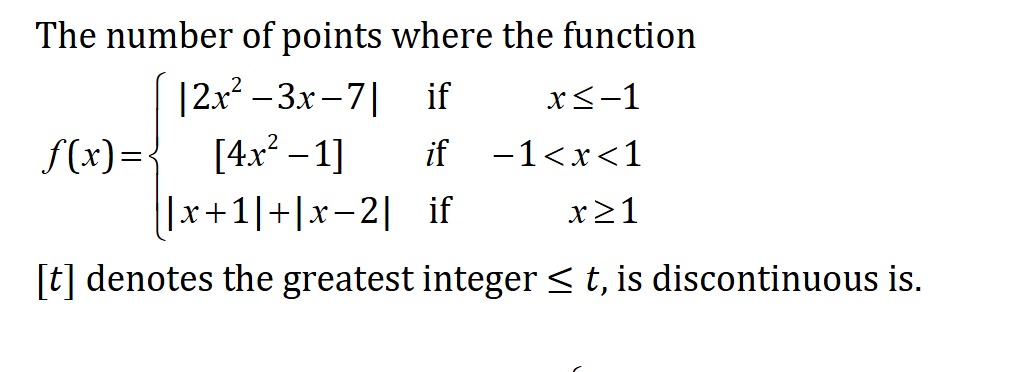Question
Question: The number of points where the function $f(x) = \begin{cases} |2x^2 - 3x - 7| & \text{if } x \leq -...
The number of points where the function
f(x)=⎩⎨⎧∣2x2−3x−7∣[4x2−1]∣x+1∣+∣x−2∣if x≤−1if −1<x<1if x≥1
[t] denotes the greatest integer ≤t, is discontinuous is.

0
1
7
8
7
Solution
The function f(x) is defined in three pieces. We analyze the continuity within each piece and at the points where the definition changes (x=−1 and x=1).
\textbf{1. For x≤−1, f(x)=∣2x2−3x−7∣:} This is a composition of continuous functions (a polynomial and the absolute value function), so it is continuous everywhere within its domain. No discontinuities arise from this piece.
\textbf{2. For −1<x<1, f(x)=[4x2−1]:} The greatest integer function [t] is discontinuous when its argument t is an integer. Let g(x)=4x2−1. We need to find values of x in the interval (−1,1) for which g(x) is an integer. Let 4x2−1=k, where k is an integer. 4x2=k+1⟹x2=4k+1. For x∈(−1,1), we have 0≤x2<1. Therefore, 0≤4k+1<1, which implies 0≤k+1<4, so −1≤k<3. The possible integer values for k are −1,0,1,2.
\begin{itemize} \item If k=−1: x2=0⟹x=0. At x=0, g(0)=−1. limx→0−[4x2−1]=[−1+]=−1. limx→0+[4x2−1]=[−1+]=−1. f(0)=[−1]=−1. Since the left-hand limit, right-hand limit, and the function value are equal, f(x) is \textbf{continuous} at x=0.
\item If $k = 0$: $x^2 = \frac{1}{4} \implies x = \pm \frac{1}{2}$.
At $x = 1/2$: $g(1/2) = 0$.
$\lim_{x \to (1/2)^-} [4x^2 - 1] = [0^-] = -1$.
$\lim_{x \to (1/2)^+} [4x^2 - 1] = [0^+] = 0$.
$f(1/2) = [0] = 0$.
Since $\lim_{x \to (1/2)^-} f(x) \neq \lim_{x \to (1/2)^+} f(x)$, $f(x)$ is \textbf{discontinuous} at $x = 1/2$.
At $x = -1/2$: $g(-1/2) = 0$.
$\lim_{x \to (-1/2)^-} [4x^2 - 1] = [0^+] = 0$.
$\lim_{x \to (-1/2)^+} [4x^2 - 1] = [0^-] = -1$.
$f(-1/2) = [0] = 0$.
Since $\lim_{x \to (-1/2)^-} f(x) \neq \lim_{x \to (-1/2)^+} f(x)$, $f(x)$ is \textbf{discontinuous} at $x = -1/2$.
\item If $k = 1$: $x^2 = \frac{1}{2} \implies x = \pm \frac{1}{\sqrt{2}}$.
At $x = 1/\sqrt{2}$: $g(1/\sqrt{2}) = 1$.
$\lim_{x \to (1/\sqrt{2})^-} [4x^2 - 1] = [1^-] = 0$.
$\lim_{x \to (1/\sqrt{2})^+} [4x^2 - 1] = [1^+] = 1$.
$f(1/\sqrt{2}) = [1] = 1$.
$f(x)$ is \textbf{discontinuous} at $x = 1/\sqrt{2}$.
At $x = -1/\sqrt{2}$: $g(-1/\sqrt{2}) = 1$.
$\lim_{x \to (-1/\sqrt{2})^-} [4x^2 - 1] = [1^+] = 1$.
$\lim_{x \to (-1/\sqrt{2})^+} [4x^2 - 1] = [1^-] = 0$.
$f(-1/\sqrt{2}) = [1] = 1$.
$f(x)$ is \textbf{discontinuous} at $x = -1/\sqrt{2}$.
\item If $k = 2$: $x^2 = \frac{3}{4} \implies x = \pm \frac{\sqrt{3}}{2}$.
At $x = \sqrt{3}/2$: $g(\sqrt{3}/2) = 2$.
$\lim_{x \to (\sqrt{3}/2)^-} [4x^2 - 1] = [2^-] = 1$.
$\lim_{x \to (\sqrt{3}/2)^+} [4x^2 - 1] = [2^+] = 2$.
$f(\sqrt{3}/2) = [2] = 2$.
$f(x)$ is \textbf{discontinuous} at $x = \sqrt{3}/2$.
At $x = -\sqrt{3}/2$: $g(-\sqrt{3}/2) = 2$.
$\lim_{x \to (-\sqrt{3}/2)^-} [4x^2 - 1] = [2^+] = 2$.
$\lim_{x \to (-\sqrt{3}/2)^+} [4x^2 - 1] = [2^-] = 1$.
$f(-\sqrt{3}/2) = [2] = 2$.
$f(x)$ is \textbf{discontinuous} at $x = -\sqrt{3}/2$.
\end{itemize} The points of discontinuity in the interval (−1,1) are x=±21,±21,±23. There are \textbf{6} such points.
\textbf{3. For x≥1, f(x)=∣x+1∣+∣x−2∣:} This function is a sum of absolute value functions, which is continuous for all x. No discontinuities arise from this piece.
\textbf{4. Checking boundary points:}
\textbf{At x=−1:} Left-hand limit: limx→−1−f(x)=limx→−1−∣2x2−3x−7∣=∣2(−1)2−3(−1)−7∣=∣2+3−7∣=∣−2∣=2. Right-hand limit: limx→−1+f(x)=limx→−1+[4x2−1]. As x→−1+, x2→1−, so 4x2−1→3−. Thus, limx→−1+[4x2−1]=[3−]=2. Function value: f(−1)=∣2(−1)2−3(−1)−7∣=2. Since limx→−1−f(x)=limx→−1+f(x)=f(−1)=2, f(x) is \textbf{continuous} at x=−1.
\textbf{At x=1:} Left-hand limit: limx→1−f(x)=limx→1−[4x2−1]. As x→1−, x2→1−, so 4x2−1→3−. Thus, limx→1−[4x2−1]=[3−]=2. Right-hand limit: limx→1+f(x)=limx→1+(∣x+1∣+∣x−2∣). For x>1 and close to 1, ∣x+1∣=x+1 and ∣x−2∣=−(x−2)=2−x. limx→1+(x+1+2−x)=limx→1+3=3. Function value: f(1)=∣1+1∣+∣1−2∣=∣2∣+∣−1∣=2+1=3. Since limx→1−f(x)=2 and limx→1+f(x)=3, f(x) is \textbf{discontinuous} at x=1.
\textbf{Conclusion:} The points of discontinuity are the 6 points in (−1,1) where [4x2−1] is discontinuous (±1/2,±1/2,±3/2), plus the point x=1. The total number of points of discontinuity is 6+1=7.
